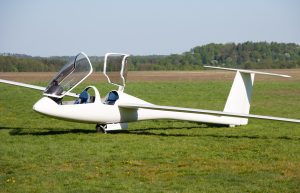 Some things you just have to take on faith. And, some things you can prove with logic and research. For most, gliders fall somewhere in the middle.
Some things you just have to take on faith. And, some things you can prove with logic and research. For most, gliders fall somewhere in the middle.
Planes and gliders are very different. If they weren’t, gliders wouldn’t glide. These are four reasons gliders fly and what makes them different than planes with motors.
Weight
Without a motor, gliders are light. They need to be to maximize hang time during flight. The entire time a glider is aloft it is battling gravity without much help, so weight matters.
High Aspect Ratio Wings
Glider wings are longer and narrower than normal. This increased wing aspect ration allows glider wings to be efficient by creating less induced drag.
Ailerons, Rudders, Elevators, and Flaps
Like most planes, gliders use control devices to steer in the sky. The difference is the glider’s control surfaces are designed specifically to produce drag and increase lift. A commercial airliner wants to quickly reach its destination. A glider wants to stay in the air as long as possible.
Glide Ratio
Commercial airliners are built with an optimum glide ratio around 15:1. Gliders come in around 60:1. That means they are designed to glide for sixty miles for every mile of altitude, four times what their motorized cousins can do.
The next time you see a glider soaring through the sky, take a second and admire the high aspect ratio of its wings, or the ability of its flaps to increase drag. Without these features, gliding wouldn’t be possible.

